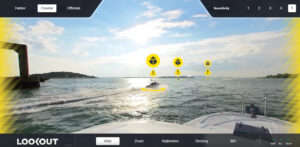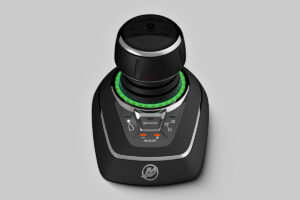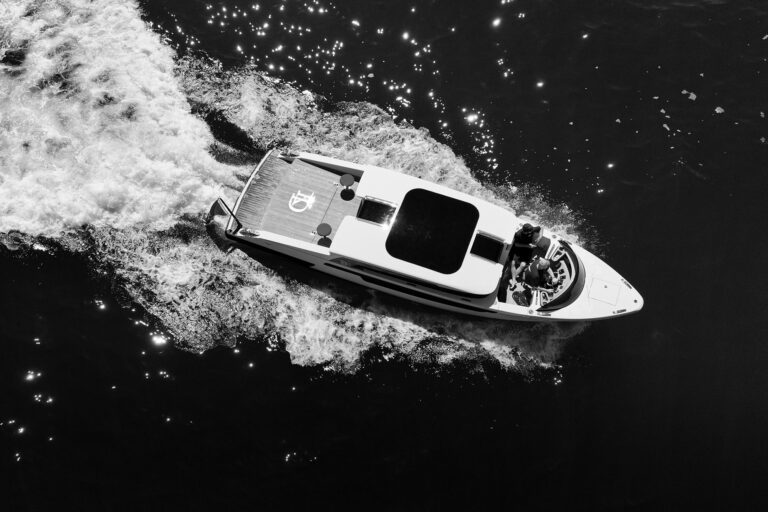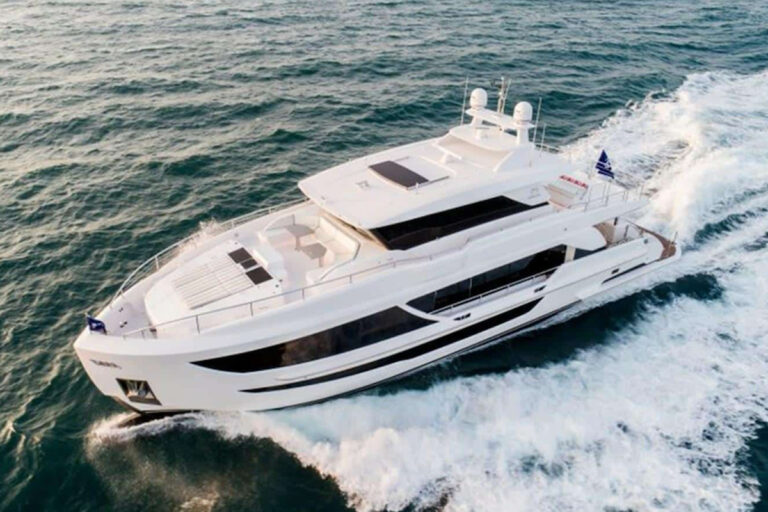Once reserved for ships and very large yachts, the marine autopilot is now an integral part of any properly equipped vessel over 20 feet in length. In fact, with the possible exception of your first mate, the autopilot is likely the most valuable member of your crew. A properly chosen, installed and operated autopilot will eliminate the tedium of steering, making your time underway more enjoyable. By precisely controlling your yacht’s rudder, the marine autopilot will allow you to maintain the high degree of situational awareness needed to assure safe navigation.
A typical autopilot system comprises five main elements: the operator control panel, the computer (which may be built into the control panel), the heading sensor, rudder drive and, in virtually all installations, a rudder-position sensor.
| Contacts AutoNav Marine Systems Inc. Brooks & Gatehouse ComNav Marine Ltd. Furuno Tecnautic Navman Nautimatic Raymarine Raytheon Simrad Sperry Marine WH Autopilots |
A bewildering variety of autopilots is available. The number of bells and whistles varies widely; however, even the most simple and unadorned pilot performs very well. Regardless of the autopilot’s control and display interface, your satisfaction with its performance will primarily be determined by how well it holds heading or tracks a course in adverse sea conditions, especially in a following sea, in which performance is largely determined by the system’s heading sensor.
The use of microprocessors has made commonplace such capabilities as automatic compensation for asymmetry in the vessel’s steering system, automatic sea state adaptation, counter-rudder and course tracking- previously reserved for the most costly units. Using GPS information some marine autopilots can automatically steer a constant course regardless of wind or current effects. A few autopilots provide both fixed and selectable angle course intercept capability similar to what is available in modern aircraft autopilots. Wireless-remote autopilot controls also are becoming popular.
Whatever the autopilot “thinks should be done must be transferred to the yacht’s rudder. Some rudder drives operate through the vessel’s hydraulic-powered steering system, while others contain their own drive element and act in parallel with the manual steering system, providing an attractive alternate means for controlling the rudder. Regardless of the type of rudder drive chosen, it must be able to exert sufficient force on the rudder shaft to cope with the most severe loading conditions, be able to move the rudder fast enough to ensure full control of the vessel and include a way to disconnect it from the rudder to allow manual control in the event of an autopilot malfunction. (If you need to work anywhere near your yacht’s steering system, be sure to pull the circuit breaker for the autopilot or otherwise prevent it from being turned on. Rudder drives can move quickly and exert more than enough force to break or crush bones.)
AutoNav’s involvement in marine autopilots dates back to 1936, to the first manual hydraulic steering system for small vessels. Today AutoNav’s autopilot range extends from vessels less than 20 feet to more than 1,000-foot-long ships. Its A-1500 fluid-dampened fluxgate-based system is designed for yacht applications and features a choice of fixed and remote cable-connected control heads equipped with LCD screens that simultaneously display course set and course steered plus rudder angle. The pilot can be interfaced with the yacht’s chart plotter/GPS using a NMEA 0183 bus.
B&G Known as Brooks and Gatehouse to those of us who remember Sir Francis Chichester’s around the world voyage in Gypsy Moth IV, B&G offers three autopilots: the entry level h1000 and the H2000 systems, the Hercules and Hydra. The h1000 systems will appeal particularly to sailors who place a high value on minimum consumption of electrical power. The Hercules and Hydra provide all the features and options expected in today’s advanced pilots. The accessory Halcyon tactical compass display and the RaceVision 2 Tablet PC will be of particular interest for the larger racing sailing yachts. B&G recently became a part of the Simrad organization.
ComNav builds autopilots suitable for use on small boats, work boats, ferries, naval vessels, megayachts and freighters. The company’s product range includes the 1420 and 1500, primarily intended for small recreational vessels, the 1201 workboat autopilot and the 1001, 1101, 2001 and 5001, optimized for yachts up to about 80 feet in length. The new ComPilot Admiral and Commander feature a plug-and-play capability that simplifies the installation process. The ComPilots provide the latest autopilot technology, including automatic bowthruster assist for dead slow or station keeping.
Furuno, best known for its radar and sonar products and systems, offers the Navpilot 500, a microprocessor-based design that uses fuzzy logic to provide adaptive learning, enabling the autopilot to progressively enhance its ability to control the boat. The system can include up to six control heads, each with 4.6-inch monochrome LCDs. Operating modes include heading, auto track (providing a ground-referenced course independent of the effects of wind or current), GPS-guided navigation to waypoints and a number of pre-programmed courses, including AutoWork for fishing boats requiring permanent trim compensation.
Navman offers the G-Pilot and the new color LCD-equipped Pilot 3380. Either unit can be used with a variety of rudder drive systems to serve the autopilot needs of a wide variety of vessels. The pilots are supplied complete with rate gyro-aided magnetic fluxgate heading sensors and rudder-position feedback sensors. (Helmsmen who are also aircraft pilots will be particularly pleased by the compass display’s resemblance to an aircraft horizontal situation indicator [HSI].) Sailors will appreciate the steer-to-wind and automatic tack/jibe functions.
Nautimatic’s Gladiator is supplied complete with a DC motor-driven hydraulic pump, rate gyro-stabilized magnetic-flux detector, control unit and handheld remote control. A wireless control is optional. The system functions without a rudder-position feedback sensor, relying instead on internally computed information. The patented Shadow Drive feature allows manual steering from the helm without having to disengage the autopilot, with automatic resumption of autopilot operation when manual steering commands terminate. The autopilot provides a number of pre-programmed steering patterns.
Raymarine’s modular SmartPilot can be configured to suit yachts with displacements up to 77,000 pounds. The typical system comprises a central course computer, a rudder drive unit and a control head. The central course computer module, or Corepack, includes a magnetic-heading sensor, a rudder-position sensor and an optional rate gyro. Three control-head options are offered, plus wired and wireless handheld controls. Sailors will appreciate the automatic tack/jibe and steer-to-wind modes.
Raytheon Marine’s Pilotstar D autopilot is produced by Raytheon Marine GmbH High Seas Products and is primarily intended for use on large yachts and commercial vessels and ships. It can be adapted to a variety of steering gear systems, including rudder propellers (azimuthing drives), twin rudders, water jets and Voith drives. Remote control stations and remote tiller controls are possible. It is directly compatible with the Raytheon Anschutz digital gyro and magnetic field sonde.
Simrad’s autopilots are designed for use on power and sail yachts as large as 60 feet. The autopilot is available in two fixed-mount configurations, the compact control head AP26 and the larger AP25, plus the handheld AP27. All use the same computer and rate gyro-assisted heading sensor and can accept information from a wind-vane sensor. The AP25 can interface with a bowthruster to provide enhanced vessel control in docking or position-keeping. Joystick, jog lever or additional control heads can be incorporated in the system. A wide variety of hydraulic pump, hydraulic linear drive and mechanical linear rudder drives are available. Simrad has also created a marine autopilot specially adapted for vessels equipped with the Volvo Penta IPS drive.
Sperry Marine’s Navipilot V is a microprocessor-controlled autopilot suitable for use on vessels ranging in size from yachts to the largest ships. Produced by Sperry’s C-Plath division, a company likely best known to yachtsmen for its world-renowned sextants, the Navipilot V is available in a wide range of configurations suitable for use with a variety of heading sensors, including north-seeking gyrocompasses and transmitting magnetic-compass systems. Up to 20 remote control/display units can be incorporated into the system. Its large ship heritage makes the Navipilot best suited for larger power yachts.
Tecnautic is a Swiss/U.S.-based company that sells its products exclusively online and has pioneered the transfer of aircraft autopilot technology to the marine market. Offered as a building-block product line it provides a wide range of control options, including steer-by-wire. Operating modes include heading, automatic course (course over the ground unaffected by current or wind), Nav (coupled to the yacht’s GPS) plus steer by wind, automatic tack and jibe for sailboats and advanced course-intercept options. When very accurate GPS information is available the “land mode will provide tracking within a few feet of the GPS-defined course.
W-H Autopilots offers three systems: the P-3C, AP-4 and P-5. The AP-4 provides the user with a wide range of control options, including automatic weather helm and adjustable counter-rudder time constant. Multiple control heads can be used, with on/off control at any station. Three types of remote control are available for use with the AP-4 pilot. A wind vane interface is available. Fluxgate compasses are used to supply heading data.
Heading Sensors Most autopilots rely upon an earth’s magnetic field sensor, a compass or its electrical equivalent, the magnetic fluxgate, to provide the heading information from which they compute steering commands. During the past few years, low cost but quite effective solid-state accelerometers and rate gyros have been added to the magnetic flux detectors, improving steering performance in rough water and most noticeably in following sea conditions, in which many autopilots are unable to safely steer the vessel. Progress continues in this area with new heading sensors incorporating additional acceleration sensors, which allow the magnetic detector to be fixed in position (so-called strapped-down sensors) rather than gimballed. Many large yachts use north-seeking gyroscopes as the heading sensor; however, GPS compass systems are becoming more popular, in part because they eliminate the need for the routine maintenance required with conventional rotating-mass gyros. Regardless of its type, the vessel’s electronic heading sensor interfaces with the vessel’s radar and chart plotter in addition to the autopilot, making it a critical part of today’s navigation suite. The bottom line is quite simple: Marine autopilot performance and, in most installations, radar and chart plotter performance depend more on the heading sensor than on any other part of the system. Some yacht owners choose special heading sensors, such as the KVH Gyrotrac or a GPS compass like those produced by Furuno and JRC. The availability of combined GPS/Loran C receivers that provide accurate heading information regardless of the yacht’s speed will likely lead to their use as a primary heading sensor.









